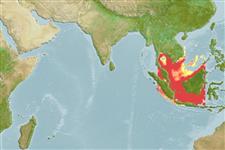>
Clupeiformes (Herrings) >
Engraulidae (Anchovies) > Coiliinae
Etymology: Setipinna: Latin, septem = seven + Latin, pinna, -ae = fin.
More on author: Bleeker.
Environment: milieu / climate zone / depth range / distribution range
Ecologie
marien; zoet water; brak water. Tropical; 19°N - 8°S, 99°E - 118°E (Ref. 189)
Western Central Pacific: Thailand south to Java, including rivers, e.g., the Chao Praya in Thailand and the Rokan, Kapuas and Barito in Indonesia and the Mekong River system.
Grootte / Gewicht / Leeftijd
Maturity: Lm ? range ? - ? cm
Max length : 33.0 cm SL mannelijk / geslacht onbekend; (Ref. 30857); common length : 19.0 cm SL mannelijk / geslacht onbekend; (Ref. 9822)
Korte beschrijving
Morfologie | Morfometrie
Dorsale stekels (totaal): 0; Anale stekels 0; Anale zachte stralen: 45 - 53. Belly with 21 to 26 + 8 to 10 = 30 to 35 keeled scutes from isthmus to anus. Lower gill rakers with serrae rather large, spiky, but not distinctly clumped. Pectoral filament short or even absent, never reaching even to anus. Gill cover and main part of pectoral fin often dusky or jet black; other fins pale to bright yellow (Ref. 189). Origin of anal fin in front of origin of the dorsal fin (Ref. 43281).
This species was recorded up rivers at 90, 150 and 210 km from the sea, but it is not known if these are permanent freshwater populations or migrants from the sea. At least small numbers enter artisanal river and lake fisheries (Ref. 9822). Found in large rivers far upstream from the estuary (Ref. 12693). Feeds mainly on insect larvae and small fishes. Used to make prahoc (Ref. 12693).
Levenscyclus en paargedrag
Maturiteit | Voortplanting | Paaien | Eieren | Fecunditeit | Larven
Wongratana, T., T.A. Munroe and M. Nizinski, 1999. Order Clupeiformes. Engraulidae. Anchovies. p. 1698-1753. In K.E. Carpenter and V.H. Niem (eds.) FAO species identification guide for fishery purposes. The living marine resources of the WCP. Vol. 3. Batoid fishes, chimaeras and bony fishes part 1 (Elopidae to Linophrynidae). FAO, Rome. (Ref. 9822)
Status op de Rode Lijst van het IUCN (Ref. 130435)
Gevaar voor de mens
Harmless
Gebruik door de mens
Visserij: visserij voor eigen gebruik
Meer informatie
Lokale namenSynoniemenMetabolismePredatorenEcotoxicologieVoortplantingMaturiteitPaaienPaaiaggregatiesFecunditeitEierenOntwikkeling van de eieren
ReferentiesAquacultuurAquacultuurprofielKweeklijnenGeneticaElectrophoresesErfelijkheidZiektesVerwerkingNutrientsMassaconversie
Tools
Speciale rapporten
Download XML
Internetbronnen
Estimates based on models
Preferred temperature (Ref.
123201): 24.1 - 28.6, mean 28 °C (based on 430 cells).
Fylogenetische diversiteitsindex (Ref.
82804): PD
50 = 0.5039 [Uniqueness, from 0.5 = low to 2.0 = high].
Bayesian length-weight: a=0.00525 (0.00303 - 0.00910), b=3.03 (2.88 - 3.18), in cm total length, based on LWR estimates for this species & (Sub)family-body (Ref.
93245).
Trofisch niveau (Ref.
69278): 3.9 ±0.63 se; based on food items.
Weerstandsvermogen (Ref.
120179): Gemiddeld, minimale populatieverdubbelingstijd 1,4-4,4 jaar (Preliminary K or Fecundity.).
Fishing Vulnerability (Ref.
59153): Low to moderate vulnerability (30 of 100).
